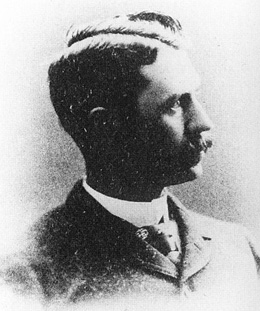Elmer H. Fisher was Seattle’s foremost commercial architect for a few years surrounding the Great Fire of 1889. His extensive Romanesque and Classical Revival building programs, which reflected the architecture of great empires of the past, asserted the economic optimism of the city rising from its ashes. This confidence propelled his initial success.
From Scotland to Seattle
Fisher was born in Edinburgh, Scotland, around 1840. Little is known of his life prior to age 40. He began practicing architecture in Victoria, British Columbia, in 1886, after years spent in Minneapolis, Denver, and Butte, Montana. He produced residential and commercial buildings in a number of Canadian cities before practicing in the state of Washington. He first moved to Port Townsend, where he designed the McCurdy Block in 1887, and quickly followed that with other commerical blocks. He opened an office in Seattle the same year; its focus was primarily commercial. Among Fisher’s designs were:
- The first Korn Building (1887-1889; destroyed)
- The Gilmore and Kirkman Building (1889-1890; destroyed)
- The Austin Bell Building (1889-1890; altered)
- The second Korn Building (1889-1890; altered)
- The Starr-Boyd Building (1889-1890; destroyed)
- The Sullivan Building (1899-1890; destroyed)
- The Lebanon Building (1889-1891; destroyed)
- The Schwabacher Building (1889-1890; altered).
Community leaders such as Henry Yesler (1810-1892) and Judge Thomas Burke (1849-1925) provided the architect with critical commissions in 1889. Fisher’s Pioneer Building and the Burke Building (now destroyed) fueled interest in his firm, which was reportedly responsible for more than 50 buildings in the 12 months after the fire. As the boom of post-fire building abated, Fisher received fewer commissions. Among his last works were the Bank of Commerce (1890-1891; altered) and the Yesler Block (1890-1891; altered), both commissioned by Henry Yesler.
Difficulties
Like many other young architects of his generation, Fisher abandoned his practice in 1891 as the tide of reconstruction ebbed. He became the proprietor of the Abbott Hotel, but lost this and other real estate investments during the economic crash of 1893. Fisher’s attempts to reestablish his practice failed, both in Seattle and in Los Angeles. He died in 1905, an architectural draftsman and carpenter.
Although the majority of Fisher’s buildings have been destroyed, the extant Pioneer Building in Pioneer Square suggests the scale, materials, and style of Seattle’s late nineteenth-century cityscape. His commercial buildings reflected the persistence of High Victorian style, which combined historical forms with modern building materials. Metal framing systems provide relatively fire-resistant skeletons for his large-scale buildings. The number of Fisher’s works suggests the output of an extensive office of draftsmen, a trend gaining momentum toward the turn of the century. Fisher’s use of materials, his compositions and stylistic formulae, as well as his office structure, reflected nation-wide changes in urban architectural practice. Despite the brevity of his architectural career, Fisher helped establish the stylistic tenor of the city’s commercial district at the turn of the twentieth century. His Pioneer Building still anchors of one of Seattle’s best-known historic districts.

